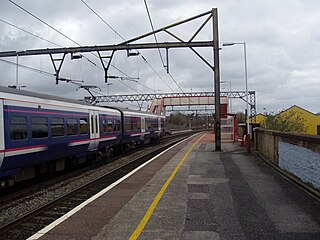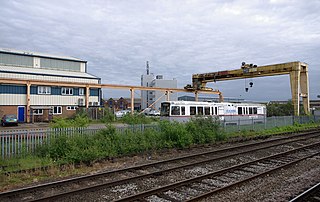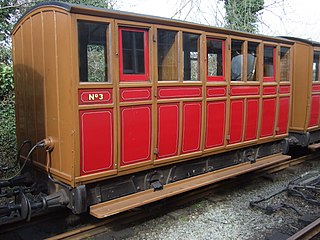History
In 1845, Joseph Wright, a London coach builder, leased land in Saltley, Birmingham with the intention of building a factory for the production of railway rolling stock. Wright, realising that the future lay in the development of the railways devoted his energies, together with those of his sons to building rolling stock and by the 1850s his Saltley site had massively expanded and he was employing a work force of about 800 people. In addition to building stock for practically all the British railways, the firm completed contracts for many countries world-wide. They also had premises in Shrewsbury.
In 1902 rationalisation of the rolling stock industry began when the Metropolitan Amalgamated Railway Carriage and Wagon Co. Ltd. was formed, incorporating Joseph Wright's old firm with other well known companies such as Ashbury, Brown and Marshalls, Oldbury and Lancaster railway carriage companies. In 1929 Vickers, after acquiring the shares of the Metropolitan Company, came together with Cammell Laird and each merged their rolling stock interests to form the great undertaking of Metropolitan-Cammell Ltd.

Vickers was a British engineering company that existed from 1828 until 1999. It was formed in Sheffield as a steel foundry by Edward Vickers and his father-in-law, and soon became famous for casting church bells. The company went public in 1867, acquired more businesses, and began branching out into military hardware and shipbuilding.

The London, Midland and Scottish Railway (LMS) was a British railway company. It was formed on 1 January 1923 under the Railways Act 1921, which required the grouping of over 120 separate railways into four. The companies merged into the LMS included the London and North Western Railway, the Midland Railway, the Lancashire and Yorkshire Railway, several Scottish railway companies, and numerous other, smaller ventures.
Cammell Laird is a British shipbuilding company. It was formed from the merger of Laird Brothers of Birkenhead and Johnson Cammell & Co of Sheffield at the turn of the twentieth century. The company also built railway rolling stock until 1929, when that side of the business was separated and became part of the Metropolitan-Cammell Carriage & Wagon Company.

Metro-Cammell, formally the Metropolitan Cammell Carriage and Wagon Company (MCCW), was an English manufacturer of railway carriages, locomotives and railway wagons, based in Saltley, and subsequently Washwood Heath, in Birmingham. The company was purchased by GEC Alsthom in May 1989; the Washwood Heath factory closed in 2005 and was demolished in early 2019.

The Birmingham Railway Carriage and Wagon Company (BRC&W) was a railway locomotive and carriage builder, founded in Birmingham, England and, for most of its existence, located at nearby Smethwick, with the factory divided by the boundary between the two places. The company was established in 1854.

British Rail Engineering Limited (BREL) was the railway systems engineering subsidiary of British Rail.
The Southern Railway (SR) gave the designations 6 PUL, 6 CITY and 6 PAN to electric multiple units built to work the routes between London and Brighton, West Worthing and Eastbourne. None of these units survived long enough in British Rail ownership to be allocated a TOPS class number. The 6 PUL units were designated 6 COR until 1935.

The London Underground 1962 Stock was a type of London Underground tube train built for use on the Central line. They were used on the Central line between 1962 and 1995, with some later being transferred to the Northern line where they were used until 1999.

Gloucester Railway Carriage and Wagon Company (GRC&W) was a railway rolling stock manufacturer based in Gloucester, England from 1860 until 1986. Products included goods wagons, passenger coaches, diesel multiple units, electric multiple units and various special-purpose vehicles. The company supplied the original fleet of red trains for the Toronto Subway, which were based upon similar vehicles to the London Underground. The company also produced pivoting sections for the Mulberry Harbour for the British War Office 1944.

Aston railway station serves the districts of Aston and Nechells in Birmingham, England. The passenger entrance is on Lichfield Road and accessable via the staircase or lifts to take you to the platform which is raised. The station is on the Cross-City Line and the Chase Line. It is one of two local stations for Aston Villa Football Club and near to the Aston Expressway and to Gravelly Hill Interchange.

Ashburys railway station serves the area of Openshaw, in Greater Manchester, England. It is a stop on a junction of the Glossop Line, the Hope Valley line and the freight line to Phillips Park Junction. It has been open since 1855 and is the nearest station to the City of Manchester Stadium.

The Ashbury Carriage and Iron Company Limited was a manufacturer of railway rolling stock founded by John Ashbury in 1837 in Commercial Street, Knott Mill in Manchester, England, near the original terminus of the Sheffield, Ashton-under-Lyne and Manchester Railway. It moved to Ashton Old Road, Openshaw in 1841 and became a limited company in 1862 as The Ashbury Railway Carriage and Iron Company Limited. Ashburys railway station is named after the company in this location. After the founder's death in 1866, the company was owned by his son, James Lloyd Ashbury. In 1898 the works covered about 20 acres (8.1 ha) and employed about 1,700.
Saltley is an inner-city area of Birmingham, England, east of the city centre. The area is part of the Washwood Heath ward, and was previously part of the Nechells ward. It is part of the Ladywood constituency in the city.

Cravens Railway Carriage and Wagon Company Limited was a railway rolling stock builder in the Darnall district of Sheffield, England. Founded by brothers named Craven and known as Craven Brothers, later Cravens Limited, it remained a family business until John Brown & Company acquired a controlling shareholding in 1919. Its name was changed back to Cravens Limited in 1954 when it finally became a wholly owned subsidiary of John Brown.

Derby Litchurch Lane Works, formerly Derby Carriage and Wagon Works, is a railway rolling stock factory in Derby, England. It is presently owned by the multinational transportation manufacturer Alstom.

Pullman trains in Great Britain were mainline luxury railway services that operated with first-class coaches and a steward service, provided by the British Pullman Car Company (PCC) from 1874 until 1962, and then by British Railways from 1962 until 1972. Many named mainline service trains have subsequently used the word 'Pullman' in their titles, but most of these have been normal trains with increased first-class accommodation. Since 1982 however, some railtours have been operated by companies using Pullman coaches dating from the 1920s to 1950s to recreate the ambience of the heyday of Pullman travel.

Brown, Marshalls and Co. Ltd. was a company that built railway carriages, based in Saltley, Birmingham, England.

CSR Corporation Limited (CSR), formerly known as China South Locomotive & Rolling Stock Corp was a Chinese manufacturer of locomotive and rolling stock.
The London Underground M Stock and N Stock were similar designs of rolling stock built in 1935. As the new cars were urgently required they were based on existing L Stock. Several years after construction both types were absorbed into the Q Stock. The last of these trains were withdrawn in 1971.
The Bristol Wagon & Carriage Works was a manufacturer of railway carriages and wagons, agricultural machinery and stationary engines, based in Bristol.
















